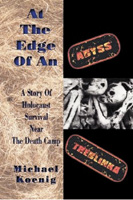Luminous survival story embedded in newly released memoir
Published October 17, 2012
At age 80, Michael Koenig lives with his wife Nomi in Tel-Aviv. He has led a full life with children, grandchildren and a successful career as an engineer and engineer-educator in the United States, and later, in Israel.
But his recently published memoir, “At the Edge of An Abyss: A Story of Survival Near the Death Camp Treblinka” (Mazo Press, $16.95, 208 pages) concentrates on the perilous period of 1939 through 1945, during World War II. It particularly focuses on the two years when Koenig, aged 10 to 12, survived 12 kilometers from the Treblinka death camp under the barn of a Christian family, which imperiled its own welfare to shelter and feed him as one of 11 people squeezed together in a hole in the ground scarcely five feet high.
Michael Koenig has a “St. Jouish” association. He lived here while employed by McDonnell Aircraft. Moreover, Koenig’s older brother, Jerry Koenig, and his wife, Linda, have been long-time residents of St. Louis where, at the St. Louis Holocaust Museum and Learning Center, Jerry regularly gives personal testimony about his family’s startling Shoah experience.
By an alphabetic coincidence, I have a personal connection to the Koenigs. On page 125 of the memoir is a compilation of ‘K’ surnames from a 1945 “Register of Jewish Survivors” [of Poland]. (Eventually 350,000 Polish Jews were believed to have survived from a pre-war population of 3.5 million.) In the left-most of three columns, entry Number 22 from the top is: Kempinski, Mordka [Mordechai], Kolo. That is my father, who, as Prisoner 143122, survived forced labor at Auschwitz.
Elie Wiesel’s memoir, “Night,” about living through Auschwitz and Buchenwald during a period in 1944 to 1945, has become Holocaust “scripture.” But initially, as Wiesel reports in the preface to the 2006 edition, publishers rejected the book on the grounds that it was too gruesome to attract a readership.
Fortunately, with a PC, and a self-publishing contract, no one need be left begging for the opportunity to tell an important story. However, I do regret to qualify my admiration for Michael Koenig’s memoir by noting that because it is self-published, it lacks the polish a book acquires through the layers of professional oversight which are standard for a commercial project.
The story steps off from Koenig’s birth in 1932 in a comfortable, merchant-class family near Warsaw and goes on to detail Germany’s easy victory over Poland, the family’s captivity in the Warsaw ghetto and eventually their extreme-hardship quarters under the Goral family’s barn.
One point of the narrative recalls how a young Koenig walked through the former Jewish section of Kosow, Poland after a massive, initial deportation of Jews to “certain death” at Treblinka. He says about “the mounds of paper, documents and hundreds of photographs…scattered in the street” that the “havoc was wreaked by local Poles” for whom the “demise of the Jews” was an “opportunity to pillage and loot their property.” This is one of several passages that does not shrink from revealing the Polish people’s contempt for Jews and persecution of them before and after the war.
There may be readers who, like me, have been distressed by the 1954 film adaptation of “The Diary of Anne Frank” with its picture of squabbling Jews represented at their very worst by Mrs. Van Daan, who was portrayed with near-fatal petulance by Shelley Winters. By contrast, Koenig’s story describes a fated fellowship that remains collaborative even when greatly tested by a view of the world shrunk to a knot hole in a barn wall; extreme temperatures; meager diet; limits on fresh air and exercise; mice, lice, and bed bugs; and when the Jews from their mass graves at Treblinka were exhumed and burned, for weeks, a hideous and pervasive stench. I leave it to readers to discover directly from Michael Koenig’s own sensitive account the tragic fate of his family’s rescuers and of the plump and healthy baby born to a young widow in the group.
Elie Wiesel’s 2006 paperback edition of “Night” travels to the outskirts of human experience in a mere 109 pages. (Wiesel has said that he was more anxious about writing too much rather than too little.) Michael’s Koenig’s memoir ambles along for 208 pages with poetry, a meditation on free will, two bar mitzvah talks, etc. But embedded within it is an account that ends at about the 100 page mark and like Wiesel’s is spare, intelligent, well-motivated—and therefore, balanced, self-effacing, free of artifice and maudlin sentiment and luminous by its menschlekh commitment to accuracy.















